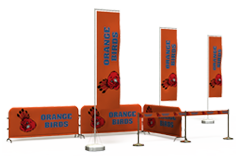About 20 years ago, the steel barrier became the dominant crowd control device. Barriers increasingly became a common sight at parades, sports events, festivals, amusement parks, concerts, and conventions. Savvy companies and event management personnel soon came to the conclusion that barriers, being so noticeable (not to mention so physically close) to large crowds, might double as a marketing/communications tool, as well as a safety tool.
History
The first attempts to accessorize barriers involved the use of banners, which were tied to the barrier itself. However, banners were very susceptible to flapping or sagging, which detracted from the image that companies or events were trying to project.
Technological advancements made it possible for vinyl jackets to be produced at the same cost, and with the same quality, as banners. In the mid-1980s, the first barrier jackets were produced. Initially, the jackets were simply one solid color.
The now-defunct Marineland theme park in California, and SeaWorld San Diego were among the first sites to use color jackets over their barriers. Solid blue-colored jackets not only appropriately matched the theme of these locations, but the jackets also protected the barriers by resisting the inherent moisture in these environments. Other sites soon began employing barrier covers for the aesthetic benefit of having their crowd control barricades fit into their color scheme.
The next step was going beyond a solid color to actually convey a message on the jacket. SeaWorld San Diego was again an early adopter, as were a number of sports facilities or teams. Many of the earliest examples of printed jackets featured a sports team’s logo, the name of an event’s sponsor (often, in those days, beer companies), or simple directional instructions, such as an arrow and the word “Parking.”
Today’s Focus
But soon, the byword was sophistication – not only in terms of physical characteristics such as fit, color, and material, but in terms of marketing strategy. How barrier jackets would look, what they would say, and where they would be utilized, became an integral part of the marketing planning of sites, events, and sponsors.
Jackets, in effect, became ground-level billboards, and again, technical advancements made it easy – and cost effective – to reproduce high-quality, attractive images on a jacket. When an event received television or news coverage, the barrier jackets became a highly visible means of conveying an image or message.
Barrier Jacket quality primer
Through trial and error, a consensus regarding today’s “standards” for barrier jackets has evolved. A quality barrier jacket will be designed with professional stitching and hems. It should be custom-fit to follow the frame profile, and fit snugly to the corners of the barrier to eliminate any potential flapping. Jackets should have a minimum of three grommets on the bottom, allowing jackets to be locked on the barrier with tie wraps; otherwise, the jacket will flap in windy conditions.
Hook and loop fastener wraps are more secure than tabs or standard strips, and the ability to wrap at both end positions is critical – this eliminates confusion about a “right end” or a “wrong end” when putting jackets on the barriers.
With today’s laser printing technology, anything that can be printed on paper can be printed on a barrier jacket. Text or logos can be placed anywhere on the jacket. If jackets are printed using the latest technology and great attention to detail, the end result should be very attractive artwork that puts forth a professional, market-focused image.
Barrier jackets marketing primer
Perhaps most importantly, jackets can turn barriers from an expense to a revenue stream. This can happen directly – companies or sponsors will pay to have their logo/message on a jacket, or indirectly – the advertising/public relations exposure payoff can easily offset the cost of a jacket.
Jackets can even have a bottom-line impact when they are used for informational purposes. When jackets provide directions, rules, or other information, it enhances the customers’ experience, leading to a favorable impression – and potential repeat business – at your site or event.
Widespread Use
Barrier jackets continue to grow in popularity, evidenced by high profile examples. Barrier jackets have been used by venues such as Radio City Music Hall and The Staples Center, sports franchises such as the Chicago Cubs and Washington Redskins, and major companies such as Budweiser and American Express.
The future
Improvements continue to be made in jacket design and printing which will only enhance clients’ satisfaction. Jackets which “bleed” beyond the traditional margins, jackets sized to flush with the ground, and reversible jackets are just a few of the recent innovations which have been introduced to customer acclaim.

Santana Jackets Designed for the House of Blues
Conclusion
Jackets can add significant value to steel barriers, and add sales and public relations value to any organization which utilizes them. They are a proven attention-getting device, an aesthetically pleasing visual alternative to an unjacketed barrier, and valuable communications tool.


